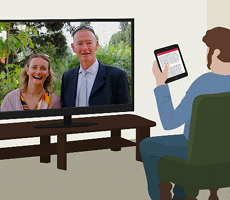- June 13, 2017
- By Chris Carroll
“There’s no way you’re listening to me while you’re looking at your phone!”
For many parents and kids, it’s a familiar refrain, but it may not be entirely true. New findings by researchers in UMD’s Department of Hearing and Speech Sciences suggest that younger people are better than their elders at understanding speech amid visual distractions like video screens, written text and other people talking in their field of vision.
One reason might be the avalanche of electronic devices and stimuli that define modern life, says the lead author the paper published in May in the Journal of the Acoustical Society of America.
“The older generation may not have all the experience multitasking younger people do,” says Julie Cohen ’08, Au.D. ’12, Ph.D. ’19.
But the researchers suspect the bulk of the measured difference is due to changes in how the brain processes speech as we age—a primary focus of the study’s co-author, Professor Sandra Gordon-Salant.
“There is a lot of research linking aging-related cognitive decline to changes in speech perception,” she says. “We’re going in a new direction by examining the effect of visual distractions.”
A large body of research focuses on how background noise can make speech difficult to understand. Other research, however, shows that certain visual cues, such as seeing a speaker’s face, facilitate understanding. This new paper flips that finding on its head to see if unhelpful visual cues could degrade speech perception.
To test that theory, Cohen showed a series of videos to 15 people in their teens and 20s, and 14 people ages 60 to 80. Each video included a “target” message spoken by a person whose face was visible on screen, along with a secondary audio message playing in the background for distracting noise. Then she added several visual distractions: text of the secondary message at the bottom of the screen, a second face on screen speaking the secondary message, and finally a video illustrating what the distracting voice was babbling about.
In short, visual distractors made it harder to focus on and understand the target message. The younger subjects, who averaged 22 years old, had little difficulty ignoring the text and second face on the screen while listening, while it was a little harder for older adults, who averaged 69 years old. Both groups struggled with the video, but the effect was much more pronounced on the older group.
There’s much more to learn about how aging and distracting visuals affect speech perception, including the timing of what’s likely a gradual decline, the researchers say. But this early research suggests that simple strategies to avoid loud visuals in noisy environments might help older people with hearing difficulties, Cohen says. “If you’re at a busy restaurant, it might be easier understanding the people you’re eating with if you’re facing the outskirts rather than where all the action is going on.”
Tags
Research